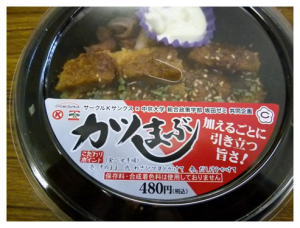XNUMX. XNUMX.Aiming for high quality active learning
Here, I would like to introduce one full-scale AL that I actually experienced.A few years ago, the seminar student in charge proposed a convenience store lunch box to Circle K Sunkus.In this initiative, under the theme of "planning lunch boxes that can be sold at convenience stores," the three participating teams spent about half a year discussing all aspects of taste, ingredients, prices, naming, packaging, etc., and proposed convenience store lunch boxes.
If it's just a name AL, it may end up just making a proposal to the company.Or, if the proposed project can be evaluated (or not), it may be a stance that "I want the company to commercialize it."Furthermore, because those who have achieved commercialization can leave it as a result of the lecture, the instructor in charge ignores the quality of the proposal and the learning of the students and asks the company "Can you somehow commercialize it?" It may even happen.However, if the purpose is to make the students face the challenges as mentioned above, think "Is it possible to overcome the more difficult challenges?" And work with the company to come up with the challenges. You can also say that.It can be said that this is a high quality AL.
In our efforts with Circle K Sunkus, one of the projects proposed by the students was highly evaluated because it was "promising for commercialization."Therefore, with the cooperation of Circle K Sunkus, we decided to give the task of "actually making a prototype with our own hands and considering whether it can be sold."The company prepares the ingredients and uses them to make a prototype.The selling price is set based on the prototype.Then, the product they (female) thought was a product with a reasonable selling price of around 1,500 yen.Of course, it can't sell.Well, what do you do?
They (female) reselect the ingredients, think about the amount to be used up to 1 g, devise the cooking method, consider the arrangement of toppings, and finally reduce the selling price to 480 yen (tax included). succeeded in.The difficulty of reducing the initially expected selling price to 1/3 is not difficult to imagine if you have been involved in product planning.
The students were also able to think about the package design on their own and reach the final sale.Of course, it goes without saying that there was a process of consulting with the people of the company "from ourselves" and obtaining a solution each time what the students did not understand during the work.So to speak, I was able to experience many of the tasks that actual business people (product planning staff) experience from among the students (* 2).
* 2: For other activities that I worked on in my seminar,Seminar homepagePlease see.

